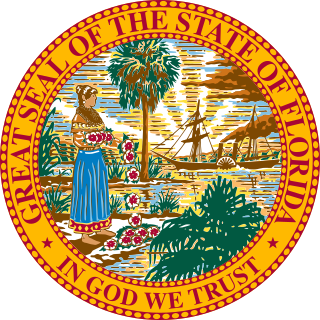The three classes of United States Senators are made up of 33 or 34 Senate seats each. The purpose of the classes is to determine which Senate seats will be up for election in a given year. The three groups are staggered so that senators in one of the groups are up for election every two years, rather than having all 100 seats up for election at once. For example, the 33 Senate seats of class 1 were up for election in 2018, the elections for the 33 seats of class 2 will take place in 2020, and the elections for the 34 seats of class 3 will be held in 2022.

The Florida Legislature is the Legislature of the U.S. State of Florida. It is organized as a bicameral body composed of an upper chamber, the Senate, and a lower chamber, the House of Representatives. Article III, Section 1 of the Florida Constitution, adopted in 1968, defines the role of the Legislature and how it is to be constituted. The Legislature is composed of 160 State Legislators. The primary purpose of the Legislature is to enact new laws and amend or repeal existing laws. The Legislature meets in the Florida State Capitol building in Tallahassee.

The California State Senate is the upper house of the California State Legislature, the lower house being the California State Assembly. The State Senate convenes, along with the State Assembly, at the California State Capitol in Sacramento.

The Tennessee Senate is the upper house of the U.S. state of Tennessee's state legislature, which is known formally as the Tennessee General Assembly.

The South Carolina Senate is the upper house of the South Carolina General Assembly, the lower house being the South Carolina House of Representatives. It consists of 46 senators elected from single member districts for four-year terms at the same time as United States Presidential elections.

The Florida Senate is the upper house of the Florida Legislature, the state legislature of the U.S. state of Florida, the Florida House of Representatives being the lower house. Article III, Section 1 of the Constitution of Florida, adopted in 1968, defines the role of the Legislature and how it is to be constituted. The Senate is composed of 40 members, each elected from a single-member district with a population of approximately 470,000 residents. Legislative districts are drawn on the basis of population figures, provided by the federal decennial census. Senators' terms begin immediately, upon their election. The Senate Chamber is located in the State Capitol building.
This is a list of members of the Australian Senate from 1987 to 1990. It consisted of twelve senators for each of the six states of Australia and two senators representing each of the Northern Territory and the Australian Capital Territory. All members were elected at the 1987 election following a double dissolution of both houses of parliament, rather than the normal case of only half of the state senators facing election.

The Delaware Senate is the upper house of the Delaware General Assembly, the state legislature of the US state of Delaware. It is composed of 21 Senators, each of whom is elected to a four-year term, except when reapportionment occurs, at which time Senators may be elected to a two-year term. There is no limit to the number of terms that a Senator may serve. The Delaware Senate meets at the Legislative Hall in Dover.

The House of Assembly of Zimbabwe is currently the lower of two chambers in the Parliament of Zimbabwe. Between 1989 and 2005, when the Senate didn't exist, the House of Assembly was the only chamber, but it was one of two chambers from independence in 1980 until 1989 and has been so again since 2005.

The number of elections in Alaska varies by year, but typically municipal elections occur every year, plus primary and general elections for federal and state offices occur during even-numbered years. Alaska has a gubernatorial election every four years. Members of the state's United States congressional delegation run for election or re-election at the times set out in the United States Constitution. Primary elections assist in choosing political parties' nominees for various positions. On a regional basis, elections also cover municipal issues. In addition, a special election can occur at any time.

The 2004 California State Senate elections were held on November 2, 2004. Senate seats of odd-numbered districts were up for election. Senate terms are staggered so that half the membership is elected every two years. Senators serve four-year terms and are limited to two terms. As was expected, the Democratic Party held on to the majority of the seats.

The 2002 California State Senate elections were held on November 5, 2002. Senate seats of even-numbered districts were up for election. Senate terms are staggered so that half the membership is elected every two years. Senators serve four-year terms and are limited to two terms. As was expected, the Democratic Party held on to the majority of the seats, though they lost one.

The 2000 California State Senate elections were held on November 7, 2000. Senate seats of odd-numbered districts were up for election. Senate terms are staggered so that half the membership is elected every two years. Senators serve four-year terms and are limited to two terms. The Democratic Party held on to the majority of the seats, gaining one seat in the process.

The 1992 California State Senate elections were held on November 3, 1992. Senate seats of odd-numbered districts were up for election. Senate terms are staggered so that half the membership is elected every two years. Senators serve four-year terms and are limited to two terms. The Democratic Party held on to the majority of the seats, though they lost two, one to a Republican and one when Lucy Killea switched from Democratic to Independent.

The 1994 California State Senate elections were held on November 8, 1994. Senate seats of even-numbered districts were up for election. Senate terms are staggered so that half the membership is elected every two years. Senators serve four-year terms and are limited to two terms. The Democrats lost two seats to the Republicans, but maintained a majority in the Senate.

The 1996 California State Senate elections were held on November 5, 1996. Senate seats of odd-numbered districts were up for election. Senate terms are staggered so that half the membership is elected every two years. Senators serve four-year terms and are limited to two terms. Democrats expanded their majority, gaining two seats, one from the Republicans and one from an Independent.

The 1998 California State Senate elections were held on November 3, 1998. Senate seats of even-numbered districts were up for election. Senate terms are staggered so that half the membership is elected every two years. Senators serve four-year terms and are limited to two terms. Democrats expanded their majority, winning a Republican-held seat and an Independent-held seat.

The United States Senate is the upper chamber of the United States Congress, which along with the United States House of Representatives—the lower chamber—comprises the legislature of the United States. The Senate chamber is located in the north wing of the Capitol, in Washington, D.C.
Section 13 of the Constitution of Australia provides for three aspects of the terms of members of the Australian Senate, the timing of elections, the commencement date of their terms and for the Senate to allocate 6 and 3-year terms following a double dissolution of the Parliament of Australia. While member of the House of Representatives have a maximum three-year term, members of the Senate have a fixed 6-year term, subject only to the parliament being dissolved by a double dissolution.












